This post may contain ads and affiliate links and we may earn a small commission when you click on the links at no additional cost to you. As an Amazon Affiliate, we earn from qualifying purchases. You can read our full disclaimer here.
Male vs Female Golden Retrievers: Behavior and Appearance
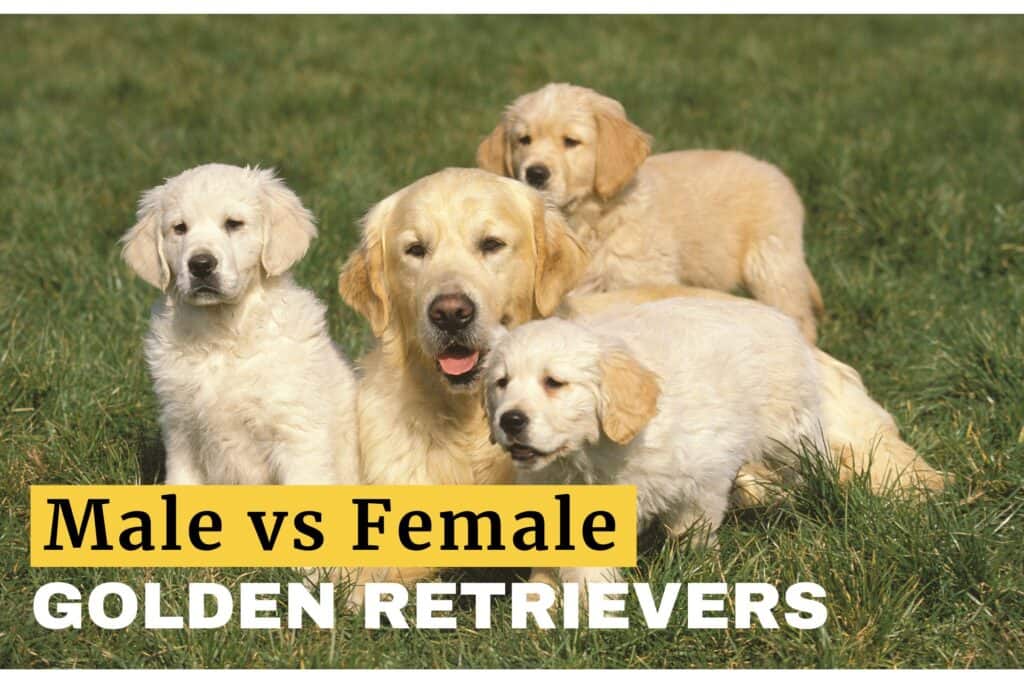
When considering bringing a Golden Retriever into my home, I quickly realized there are notable differences between males and females that could influence my decision.
Male Golden Retrievers generally are larger. They stand 22-24 inches tall and weigh between 65-75 pounds.
On the other hand, female Golden Retrievers tend to be slightly smaller, with typical heights of 20-22 inches and weights ranging from 55-65 pounds.
It’s not just about size, though; the distinctions go deeper than mere measurements.
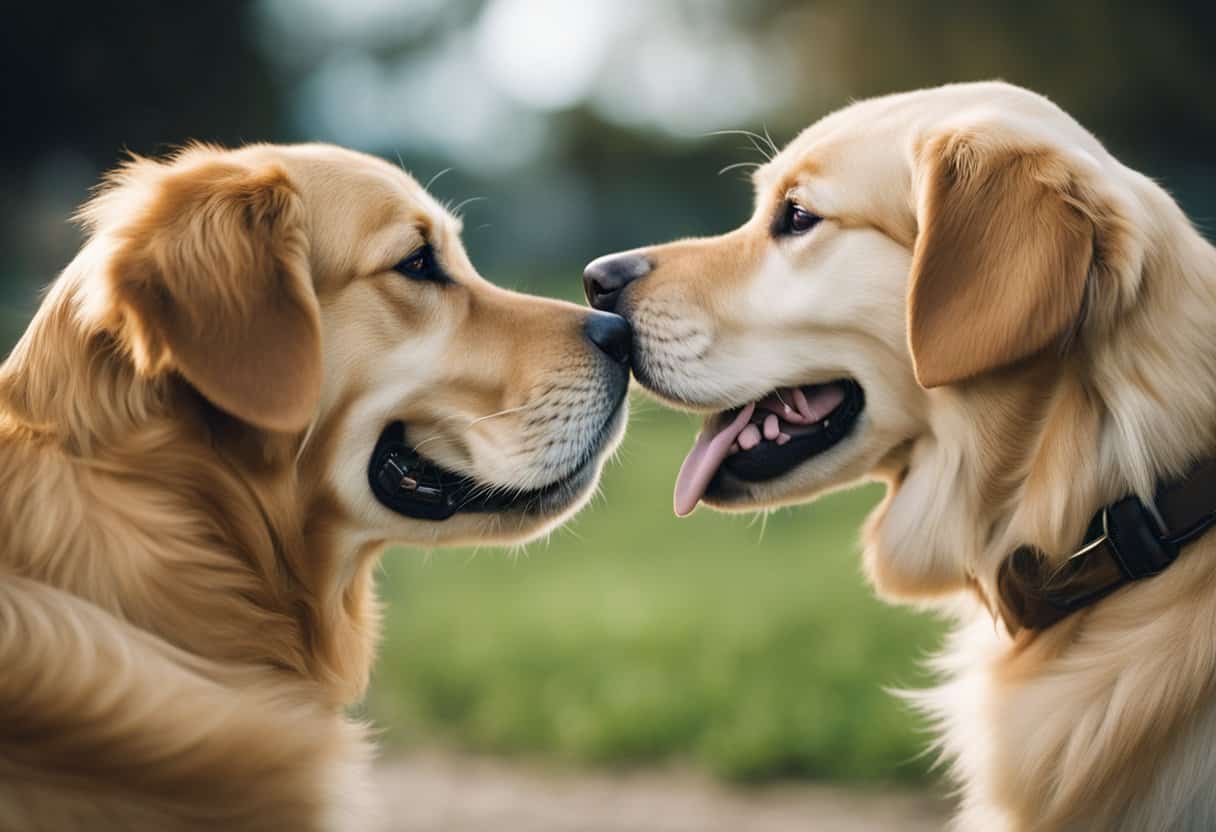
In my exploration of male vs. female Golden Retrievers, I found that personality traits can also vary between sexes.
While males often maintain their playful, puppy-like energy well into adulthood, females usually mature faster. This has implications for training and the day-to-day dynamic in my home.
I’ve come to understand that these differences don’t make one sex better than the other. Rather, they offer a choice that can be tailored to fit into different lifestyles and preferences.
When I compare male and female Golden Retrievers, I’m looking at distinct traits in their physical makeup.
From size differences to variations in coat color, these aspects are what set the males apart from the females in this beloved breed.
Size and Build
Males of the breed typically exhibit a broader, more robust build compared to females. Their chest appears deeper and their shoulders are broader, giving them a sturdy, muscular appearance.
Height and Weight
Males are generally taller and heavier than females.
- Male Golden Retrievers
- Height: Typically 22-24 inches
- Weight: Usually falls between 65-75 pounds
- Female Golden Retrievers
- Height: Around 20-22 inches
- Weight: Tends to range from 55-65 pounds
Some exceptionally large males can exceed this weight range, reaching up to 80 pounds or more.
This substantial size contributes to their strong and sturdy build, ideal for retrieving, fieldwork, and other physically demanding activities.
Coat and Colors
No significant color differences exist between male and female Golden Retrievers, as both genders can exhibit the full range of the breed’s colors, from light cream to a rich golden.
Their hair length, texture, and shedding patterns also remain similar, irrespective of gender.
Behavioral Traits
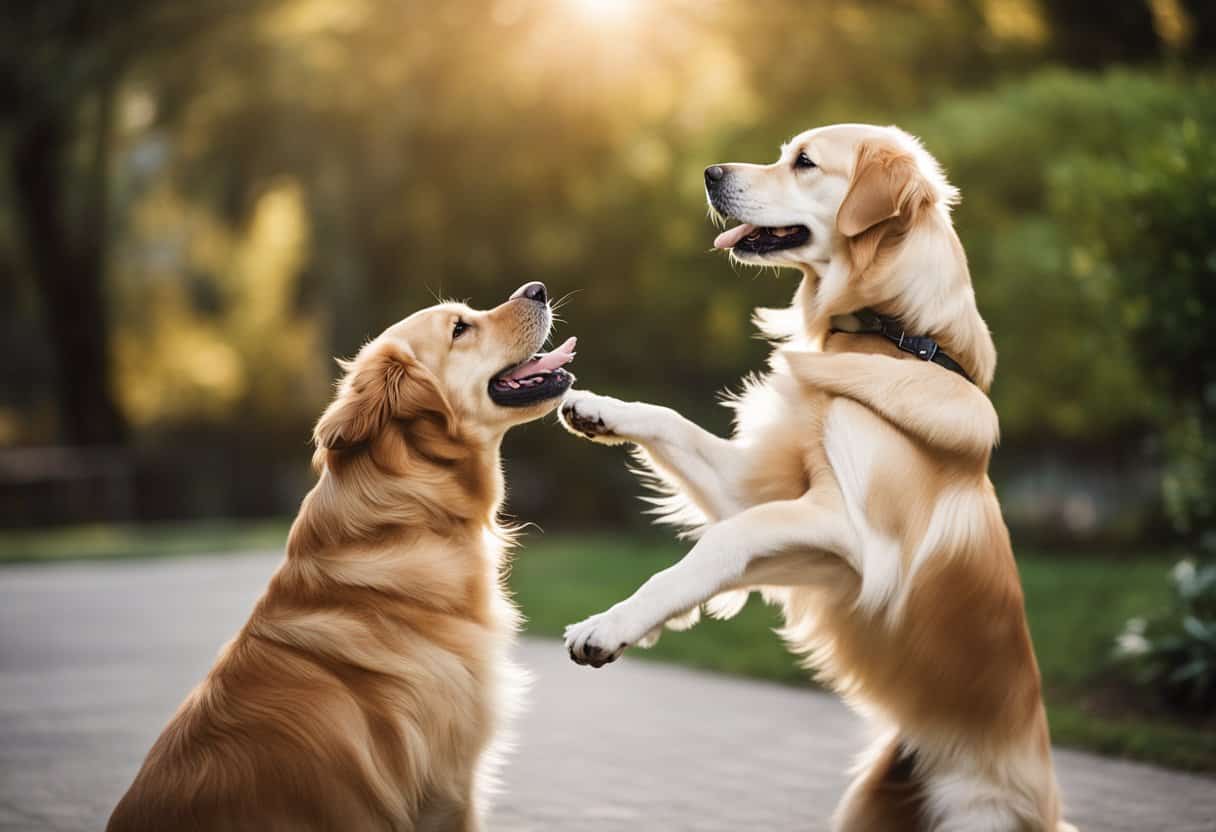
In my experience with Golden Retrievers, I’ve noticed that their behavioral traits often vary between males and females, especially in terms of personality, training receptiveness, and interaction with children and other pets.
Personality and Temperament
When I consider the personality of Golden Retrievers, I see that males tend to display a playful and sometimes more boisterous temperament.
They are known for retaining puppy-like energy for a longer period, which translates into an affectionate but very active demeanor.
In contrast, females usually exhibit a more mature approach faster than males. They might be slightly more independent, but still share the breed’s inherent affectionate and loyal nature.
Training and Obedience
Regarding training, I’ve found that both male and female Golden Retrievers show high levels of intelligence and trainability.
One noteworthy distinction I’ve observed is that females might excel in training sessions due to their faster mental maturity.
They often seem to have better focus and might respond to obedience commands with more consistency.
Males, while intelligent, may require more patience during training as their playful demeanor can sometimes be a distraction.
Socialization with Children and Pets
The Golden Retriever’s affectionate personality makes it a great companion for children.
I’ve observed that females can be protective and nurturing towards kids, which aligns with their maternal instincts.
Conversely, males can be incredibly playful and affectionate, making them wonderful playmates for children as long as their size and energy are taken into account.
With proper introduction and socialization, both genders typically interact well with other pets, exuding the breed’s characteristic friendliness and loyalty.
Health and Lifespan
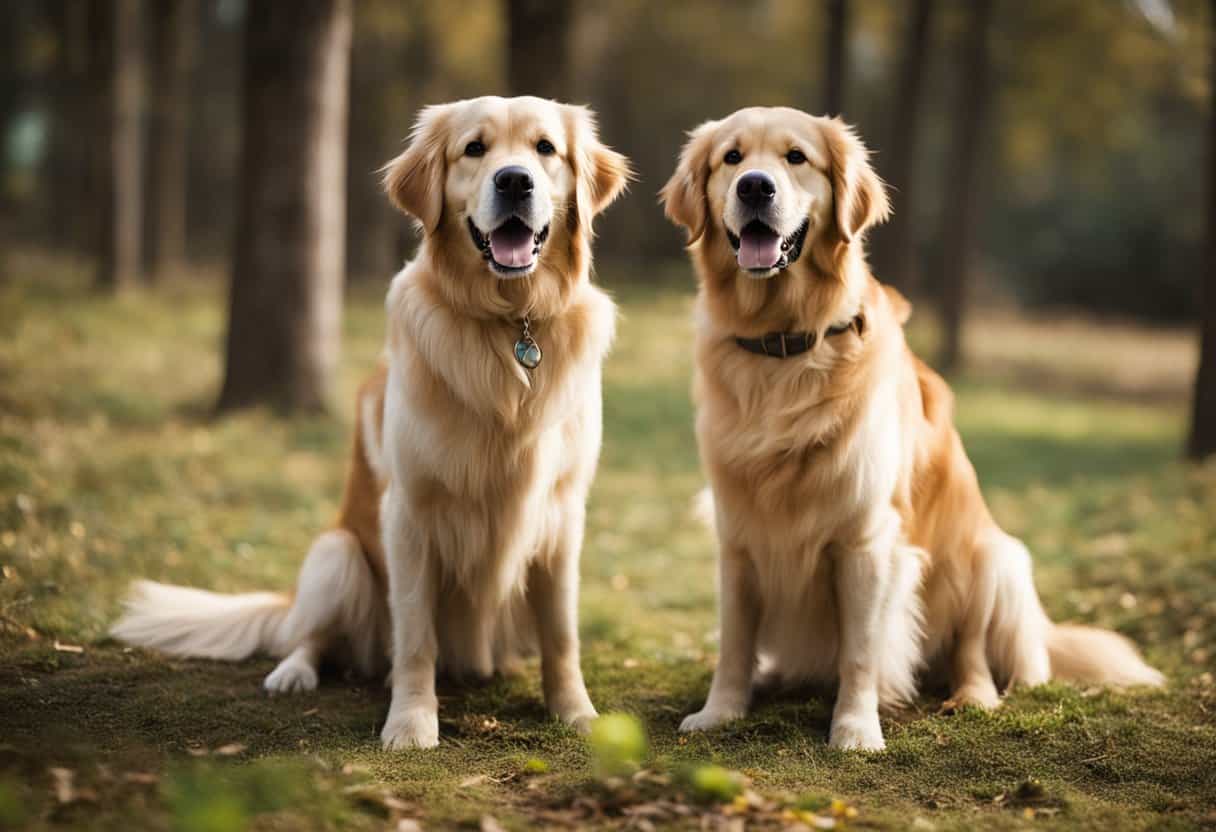
It’s clear that both males and females are prone to certain health concerns, which can affect their overall lifespan. Responsible breeding, as well as timely spaying or neutering, can have significant implications for their health.
Common Health Concerns
Golden Retrievers are known for their friendly disposition, but they, unfortunately, come with a predisposition to certain health issues.
Cancer is a major concern, affecting both genders, but it seems to have a slightly higher incidence in males.
Hip dysplasia is another common genetic concern that can impact these dogs, potentially leading to arthritis and mobility problems later in life.
Here’s a brief list of health issues to keep an eye on:
- Cancer (most notably hemangiosarcoma and lymphoma)
- Hip dysplasia
- Heart disease
- Eye conditions
Responsible breeding practices are crucial for reducing these genetically inherited conditions.
Neutering and Spaying Effects
Deciding when to neuter or spay my Golden Retriever was guided by health considerations.
Neutering males can reduce the risk of testicular cancer and certain prostate issues. Meanwhile, spaying females can prevent pyometra, a serious uterine infection, as well as mammary cancer, especially if done before the first heat.
Here’s a summarized effect of these procedures:
- Neutering males:
- Reduces the risk of testicular cancer and certain prostate diseases.
- May potentially affect growth if done too early.
- Spaying females:
- Lowers the risks of mammary cancer and pyometra.
- Should be timed correctly to avoid negative impacts on growth plate development.
Reproductive Behavior
Understanding the reproductive behavior of Golden Retrievers is vital for any potential owner.
For both male and female Golden Retrievers, behavior linked to reproduction can include marking and mounting tendencies.
These behaviors are influenced by hormonal changes particularly noticeable during a female’s heat cycle.
Heat and Estrus Cycle
In the world of Golden Retrievers, the females have a heat cycle, also known as the estrus cycle.
During this period, which occurs roughly every six months, a female dog becomes fertile and is capable of reproducing. Here’s a quick rundown of the stages:
- Proestrus: Lasting about 9 days, this is when males are attracted to the female, but she’s not yet receptive.
- Estrus: This is the actual fertile phase, lasting 9 days as well, where the female will accept a male.
- Diestrus and Anestrus: These are the non-receptive phases where the female’s body resets.
Maternal and Paternal Instincts
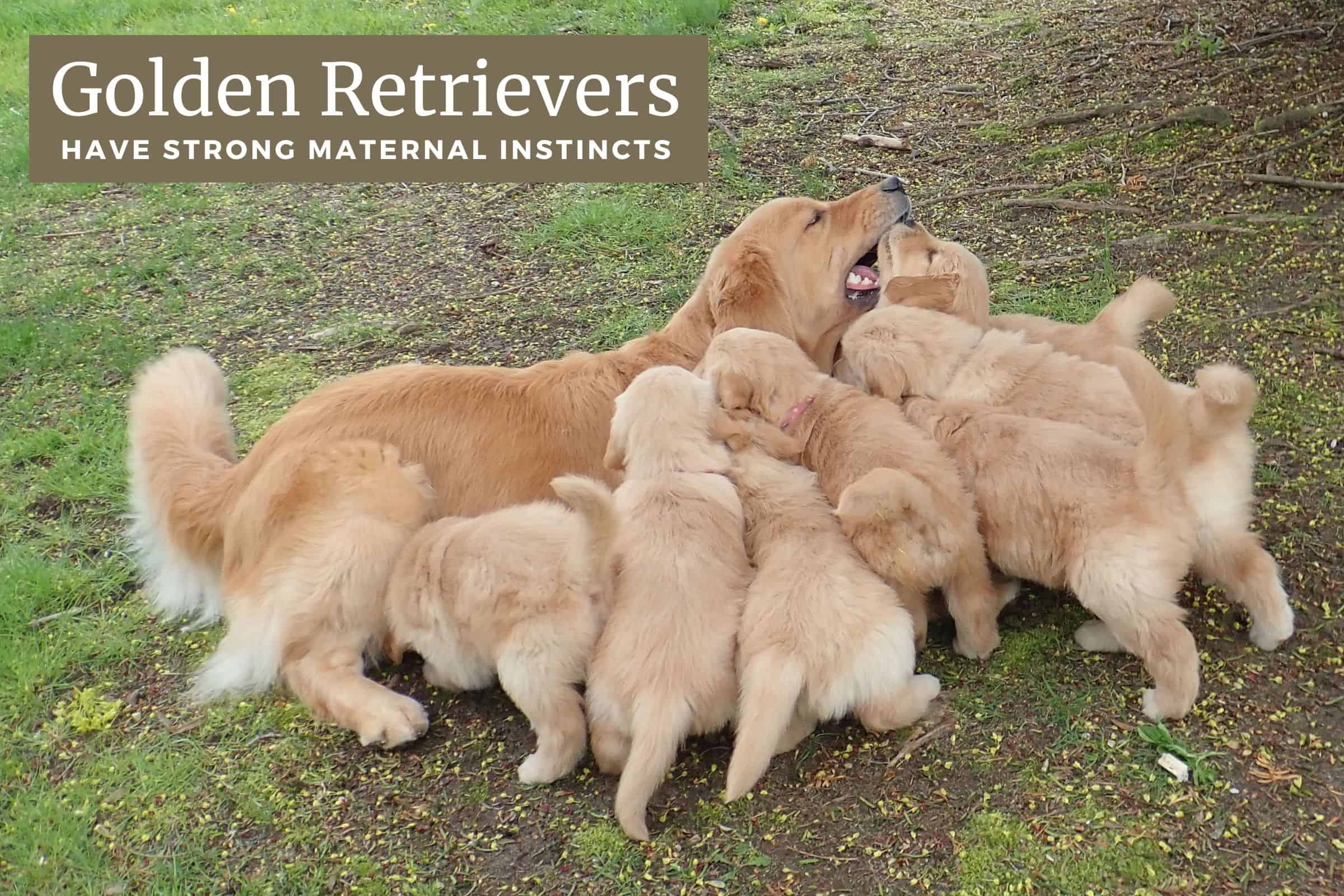
When it comes to the parental instincts of Golden Retrievers, typically, the female dog exhibits strong maternal instincts, especially after giving birth.
They care for, protect, and nurture their puppies with great dedication.
On the other hand, the male dog might show some paternal behaviors, but they are not as involved in direct care.
Males can sometimes be indifferent or even unaware of the offspring, which contrasts with the female’s nurturing tendencies.
While both sexes may exhibit behaviors such as marking territory or even humping as part of their reproductive systems, these actions are more prominent and frequent in males, especially if they haven’t been neutered.
Daily Care and Maintenance

Caring for a Golden Retriever requires an understanding of their exercise, grooming, and dietary needs which vary slightly between males and females.
Exercise and Energy Levels
For exercise, you should know that males and females have different energy levels and exercise needs.
Males have a high energy level and need ample exercise. I recommend at least 1 hour daily; activities like fetching, running, and swimming are ideal.
On the other hand, females have a slightly lower energy level. They still need plenty of exercise, but daily walks and playtime for about 45-60 minutes can suffice.
Grooming Requirements
Males and Females:
- Coat Care: Both require regular brushing. Males might have a fuller coat.
- Brushing Schedule: At least twice a week to prevent matting and reduce shedding.
- Bathing: Once a month or as needed, using dog-specific shampoo.
Diet and Nutrition
- Meals: I prefer splitting their diet into two meals per day.
- Portion Sizes: Larger for males due to their size. Males need about 3-4 cups, while females need 2-3 cups.
- Dietary Considerations: High-quality dog food with lean protein supports their active lifestyle.
Training Challenges
I’ve noticed some distinct challenges in training males compared to females. These challenges often revolve around their differences in development and temperament.
Potty Training Differences
I find that female Golden Retrievers can be easier to potty train due to their typically fast maturing nature.
They generally seem to pick up on the concept quickly and may have fewer accidents in the house if consistent training routines are put in place.
In contrast, male Golden Retrievers might take a bit longer to grasp potty training. Their playful and sometimes easily distracted nature can extend the time it takes to fully potty train them.
Obedience and Independence
When it comes to obedience training, females often take to it with diligence. They show a desire to please that helps with consistency and reliability.
Males, while equally intelligent, can sometimes exhibit a more independent streak. This may require a bit more patience and creativity in the training sessions.
It’s not that male Goldens aren’t capable of being well-trained; rather, they might just test boundaries more often during their training period.
Emotional and Psychological Aspects

In my time with Golden Retrievers, I’ve seen distinctive emotional and psychological traits that vary slightly between males and females.
Their displays of affection, loyalty, and coping mechanisms such as dealing with separation anxiety are all important facets of their personalities and behaviors.
Affection and Loyalty
Male Golden Retrievers are often seen as more gregarious and attention-seeking, which may translate to affectionate behavior toward family members. They may follow me around more often and are keen to be involved in activities together.
On the other hand, female Golden Retrievers tend to be more independent. Although they are affectionate, their displays of love can be more subtle, and they at times prefer space.
Regardless of gender, loyalty is a cornerstone of the breed’s temperament.
Both males and females show a deep loyalty to their family members, often positioning themselves as protective companions.
Separation Anxiety and Coping
When it comes to separation anxiety, I’ve noticed that Golden Retrievers can be prone to it due to their strong bond with their owners.
Female Golden Retrievers might cope with my absence by finding a quiet place to wait, often being calmer during times of separation.
In contrast, male Golden Retrievers might express their anxiety more outwardly. They might show it through persistent barking or physical activity.
The coping mechanisms of each dog can be influenced by their upbringing and training. It’s crucial to provide consistent companionship and mental stimulation to help both males and females manage emotions like separation anxiety.
Social Interactions and Compatibility
In my experience with Golden Retrievers, their social interactions and compatibility differ subtly between males and females, particularly in how they relate with other dogs and family members.
With Other Dogs
I’ve noticed that male Golden Retrievers tend to be very playful and friendly when interacting with other dogs. They exhibit high energy levels which can be great in playful environments.
However, they may also sometimes be more assertive or dominant. This requires careful socialization from a young age to ensure positive interactions.
Female Golden Retrievers, on the other hand, often display more measured temperaments. They can be as friendly as males but tend to be less prone to dominance behaviors.
Females might be more selective with their canine companions, but proper socialization can help them become well-adjusted to various social scenarios with other dogs.
With Family and Children
Regarding interactions with family and particularly children, I’ve found that both male and female Golden Retrievers generally have a friendly and gentle temperament, making them well-suited to family life.
Males can be more affectionate and may seek attention more than females, enjoying being involved in all family activities.
Females can be equally as loving but might sometimes show an independent streak. They tend to be protective and make attentive, caring companions for children.
Their nurturing nature can create a strong, loyal bond with family members.
Considerations for Prospective Owners
Before diving into the specifics of male and female Golden Retrievers, I think it’s important to understand how these aspects align with your lifestyle and expectations.
Choosing the right gender can impact the dynamic of your household as well as how you’ll need to prepare for your new furry friend.
Choosing Between Male and Female Golden Retrievers
When choosing between a male and a female Golden Retriever, several factors can guide your decision.
While both are excellent choices for families, understanding your specific needs will help you determine which is better for your home.
Consider Your Living Space
If you have a spacious home with a large backyard, a male Golden Retriever might be a good fit. They generally grow larger and require more space to move around.
If you’re in an apartment or a smaller house, a female’s smaller size could be more manageable.
Think About Energy Levels
Families with active lifestyles might lean towards males, who are typically more energetic and playful. If you have children who enjoy playing outdoors, a male Golden Retriever could keep them entertained.
If your family prefers a quieter environment, a female’s calmer demeanor might suit you better.
Training and Obedience
Consider who will be training your Golden Retriever. If you need a dog that’s quick to learn and responsive to commands, a female could be the ideal choice.
They tend to be more focused and attentive during training. If you’re okay with a more laid-back dog, a male can be just as trainable but might require a bit more patience.
Health and Longevity
Another factor to consider is health. Females generally live longer and have fewer health risks. Males, while robust, can be prone to specific issues like prostate problems.
If you’re concerned about long-term health, a female might be the better choice. However, spaying and neutering can affect health risks for both genders.
Protection and Security
Families seeking a dog with a strong protective instinct might prefer a female. They tend to be more protective of their family and home.
If you’re more interested in a friendly companion who isn’t as territorial, a male Golden Retriever could be the right choice.
Family Dynamics
Your family dynamics play a crucial role in choosing between a male and a female Golden Retriever. Consider the ages of your children, your lifestyle, and how much time you can dedicate to training and exercise.
Both genders are excellent for families, but your choice should align with your specific circumstances.
Making Your Decision
Ultimately, your decision should be based on what fits best with your family’s lifestyle and preferences.
By considering factors like living space, energy levels, training, health, and protection, you can choose between a male and a female Golden Retriever with confidence.
Regardless of your choice, both genders offer the loyalty and love that make Golden Retrievers a beloved family pet.
Preparing for a Golden Retriever
Welcoming a Golden Retriever into my life meant preparing for a high-energy breed. They are respected for their friendliness and compatibility with families.
It’s essential to ready your home with ample space for exercise and play. I always advocate for potential owners to have a strategy for regular exercise and mental stimulation. This is to ensure a happy and healthy companion.
Whether you choose a male or female, both will demand similar levels of commitment to grooming due to their luxurious coats. They will also benefit from consistent training to hone their natural temperament into well-behaved behavior.
Preparing for a Golden, one must be ready for a loving and attentive dog that thrives on companionship and activity.
By considering these elements, you’ll be better equipped to decide which gender may be the best fit for your home and how to prepare adequately for their arrival.
-

Coffee Mug – In Dog Coffees I’ve Only Had One
Price range: $11.95 through $14.95 Select options This product has multiple variants. The options may be chosen on the product page
